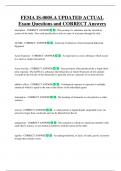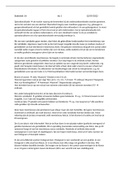2020/2021
MANAGERIAL ECONOMICS, BUSINESS &
POLITICS
LECTURE NOTES
SÁ PESSOA DOS SANTOS, J.C. (JOANA)
LEIDEN UNIVERSITY
MSc Public Administration
,Table of Contents
Lecture 1 – Introduction & the Nonmarket Environment ................................................................ 5
Part I – Introduction ................................................................................................................................ 5
The environment of business............................................................................................................ 5
Part II – Analysing the nonmarket environment ..................................................................................... 6
Broader picture.................................................................................................................................... 6
Differences between the market & nonmarket environment .............................................................. 6
Analysis of the nonmarket environment: The Four I’s ....................................................................... 6
Issues ................................................................................................................................................... 7
The nonmarket issue life cycle............................................................................................................ 7
Interests ............................................................................................................................................... 8
Part III – Integrated strategies ............................................................................................................... 11
Summary ............................................................................................................................................... 12
Lecture 2 – Public Institutions ........................................................................................................... 13
Part I: Supply and Demand for Non-Market Action ............................................................................. 13
Interests ............................................................................................................................................. 13
The amount of nonmarket action ...................................................................................................... 14
Nonmarket action & free-rider problem ........................................................................................... 17
Effectiveness of non-market action................................................................................................... 20
Summary of supply side of NMA ..................................................................................................... 21
Distributive politics spreadsheet ....................................................................................................... 21
Part II – What is the nature of political competition? ........................................................................... 22
Putting the pieces together ................................................................................................................ 22
Nature of political competition ......................................................................................................... 22
Part III: Strategy Formulation ............................................................................................................... 25
Summary ............................................................................................................................................... 30
Seminar 3 – Public Politics II and EU Institutions .......................................................................... 31
Part I: Strategy Implementation ............................................................................................................ 31
Lobbying ........................................................................................................................................... 31
Multilevel lobbying........................................................................................................................... 31
Principles of effective lobbying ........................................................................................................ 32
Access ............................................................................................................................................... 32
Credibility and relevance of information .......................................................................................... 32
Part II: Which institutions set public policy in the EU?........................................................................ 33
1
, EU Institutions .................................................................................................................................. 33
European Commission ...................................................................................................................... 33
The Council of the EU ...................................................................................................................... 35
European Parliament ......................................................................................................................... 39
Part III – Policymaking Process in the EU ........................................................................................... 40
(1) Consultation procedure ............................................................................................................... 40
(2) Co-decision procedure................................................................................................................. 41
An important side note on the legislative process in the EU ............................................................ 43
Seminar 4: Introduction to Political Analysis .................................................................................. 44
Part I – Criticism of non-market action model ..................................................................................... 44
Institutions ........................................................................................................................................ 44
Maximising social welfare ................................................................................................................ 44
What SWF do we use? ...................................................................................................................... 44
Part II – Social Choice Theory as an answer ........................................................................................ 47
An alternative approach .................................................................................................................... 47
Condorcet Paradox ............................................................................................................................ 49
Arrows’ Impossibility Theorem (1951) ............................................................................................ 50
Example 1: Plurality voting .............................................................................................................. 50
Example 2: Borda Count & IIA ........................................................................................................ 52
Why is this important? ...................................................................................................................... 53
Agenda-setting .................................................................................................................................. 54
Strategic voting ................................................................................................................................. 54
Gibbard-Sattherwaite’s Theorem ...................................................................................................... 55
What we have learned in Part II ........................................................................................................ 55
Part III – A spatial model of political decision-making ........................................................................ 55
History of the spatial model .............................................................................................................. 55
Spatial model of politics ................................................................................................................... 56
Seminar 5 – Spatial Theory ................................................................................................................ 58
Part I – Spatial Theory of Voting: One Dimension............................................................................... 58
Policies as points in space ................................................................................................................. 58
Preliminaries: Utility......................................................................................................................... 58
Key elements of a spatial analysis of politics ................................................................................... 60
1.Preferences ..................................................................................................................................... 60
2.Alternatives .................................................................................................................................... 62
3.The rules......................................................................................................................................... 64
2
, Assumptions of a spatial theory of voting ........................................................................................ 64
Example of spatial analysis ............................................................................................................... 64
Black’s Median Voter Theorem (MVT) ........................................................................................... 67
Median Voter Theorem Conditions for Applicability....................................................................... 69
Usefulness of MVT ........................................................................................................................... 69
Part II – Spatial Theory of Voting: Two Dimensions ........................................................................... 70
Two dimensions example of legislators voting on preferred budget ................................................ 74
Useful sets ......................................................................................................................................... 77
Pareto set ........................................................................................................................................... 77
Chaos result of public choice theory ................................................................................................. 81
Part III – Spatial Theory of Voting: Further Complexities ................................................................... 82
Equilibrium for larger majorities ...................................................................................................... 82
Example 1 ......................................................................................................................................... 82
Example 2 ......................................................................................................................................... 83
Example 3 ......................................................................................................................................... 84
Pivotal Politics .................................................................................................................................. 84
Gridlock ............................................................................................................................................ 85
Supermajority rule in two dimensions .............................................................................................. 85
Summary ........................................................................................................................................... 86
Seminar 6 – Predicting Policy in the EU ........................................................................................... 88
Part I – Spatial Theory applied to the EU ............................................................................................. 88
Conditions of Spatial Model of voting .............................................................................................. 88
The European Commission ............................................................................................................... 88
The European Parliament .................................................................................................................. 89
The Council of the EU ...................................................................................................................... 89
The Commission, EP and Council in a single model ........................................................................ 90
Game theoretical form ...................................................................................................................... 90
The Consultation procedure .............................................................................................................. 90
The Co-decision procedure ............................................................................................................... 93
Conclusions for nonmarket strategy ................................................................................................. 96
Strategic use of the Gridlock interval ............................................................................................... 97
Part II – Empirical validity of the spatial model ................................................................................... 98
Empirics on the gridlock interval .................................................................................................... 103
Part III – Ideal points in practice......................................................................................................... 105
Voting records ................................................................................................................................. 105
3
MANAGERIAL ECONOMICS, BUSINESS &
POLITICS
LECTURE NOTES
SÁ PESSOA DOS SANTOS, J.C. (JOANA)
LEIDEN UNIVERSITY
MSc Public Administration
,Table of Contents
Lecture 1 – Introduction & the Nonmarket Environment ................................................................ 5
Part I – Introduction ................................................................................................................................ 5
The environment of business............................................................................................................ 5
Part II – Analysing the nonmarket environment ..................................................................................... 6
Broader picture.................................................................................................................................... 6
Differences between the market & nonmarket environment .............................................................. 6
Analysis of the nonmarket environment: The Four I’s ....................................................................... 6
Issues ................................................................................................................................................... 7
The nonmarket issue life cycle............................................................................................................ 7
Interests ............................................................................................................................................... 8
Part III – Integrated strategies ............................................................................................................... 11
Summary ............................................................................................................................................... 12
Lecture 2 – Public Institutions ........................................................................................................... 13
Part I: Supply and Demand for Non-Market Action ............................................................................. 13
Interests ............................................................................................................................................. 13
The amount of nonmarket action ...................................................................................................... 14
Nonmarket action & free-rider problem ........................................................................................... 17
Effectiveness of non-market action................................................................................................... 20
Summary of supply side of NMA ..................................................................................................... 21
Distributive politics spreadsheet ....................................................................................................... 21
Part II – What is the nature of political competition? ........................................................................... 22
Putting the pieces together ................................................................................................................ 22
Nature of political competition ......................................................................................................... 22
Part III: Strategy Formulation ............................................................................................................... 25
Summary ............................................................................................................................................... 30
Seminar 3 – Public Politics II and EU Institutions .......................................................................... 31
Part I: Strategy Implementation ............................................................................................................ 31
Lobbying ........................................................................................................................................... 31
Multilevel lobbying........................................................................................................................... 31
Principles of effective lobbying ........................................................................................................ 32
Access ............................................................................................................................................... 32
Credibility and relevance of information .......................................................................................... 32
Part II: Which institutions set public policy in the EU?........................................................................ 33
1
, EU Institutions .................................................................................................................................. 33
European Commission ...................................................................................................................... 33
The Council of the EU ...................................................................................................................... 35
European Parliament ......................................................................................................................... 39
Part III – Policymaking Process in the EU ........................................................................................... 40
(1) Consultation procedure ............................................................................................................... 40
(2) Co-decision procedure................................................................................................................. 41
An important side note on the legislative process in the EU ............................................................ 43
Seminar 4: Introduction to Political Analysis .................................................................................. 44
Part I – Criticism of non-market action model ..................................................................................... 44
Institutions ........................................................................................................................................ 44
Maximising social welfare ................................................................................................................ 44
What SWF do we use? ...................................................................................................................... 44
Part II – Social Choice Theory as an answer ........................................................................................ 47
An alternative approach .................................................................................................................... 47
Condorcet Paradox ............................................................................................................................ 49
Arrows’ Impossibility Theorem (1951) ............................................................................................ 50
Example 1: Plurality voting .............................................................................................................. 50
Example 2: Borda Count & IIA ........................................................................................................ 52
Why is this important? ...................................................................................................................... 53
Agenda-setting .................................................................................................................................. 54
Strategic voting ................................................................................................................................. 54
Gibbard-Sattherwaite’s Theorem ...................................................................................................... 55
What we have learned in Part II ........................................................................................................ 55
Part III – A spatial model of political decision-making ........................................................................ 55
History of the spatial model .............................................................................................................. 55
Spatial model of politics ................................................................................................................... 56
Seminar 5 – Spatial Theory ................................................................................................................ 58
Part I – Spatial Theory of Voting: One Dimension............................................................................... 58
Policies as points in space ................................................................................................................. 58
Preliminaries: Utility......................................................................................................................... 58
Key elements of a spatial analysis of politics ................................................................................... 60
1.Preferences ..................................................................................................................................... 60
2.Alternatives .................................................................................................................................... 62
3.The rules......................................................................................................................................... 64
2
, Assumptions of a spatial theory of voting ........................................................................................ 64
Example of spatial analysis ............................................................................................................... 64
Black’s Median Voter Theorem (MVT) ........................................................................................... 67
Median Voter Theorem Conditions for Applicability....................................................................... 69
Usefulness of MVT ........................................................................................................................... 69
Part II – Spatial Theory of Voting: Two Dimensions ........................................................................... 70
Two dimensions example of legislators voting on preferred budget ................................................ 74
Useful sets ......................................................................................................................................... 77
Pareto set ........................................................................................................................................... 77
Chaos result of public choice theory ................................................................................................. 81
Part III – Spatial Theory of Voting: Further Complexities ................................................................... 82
Equilibrium for larger majorities ...................................................................................................... 82
Example 1 ......................................................................................................................................... 82
Example 2 ......................................................................................................................................... 83
Example 3 ......................................................................................................................................... 84
Pivotal Politics .................................................................................................................................. 84
Gridlock ............................................................................................................................................ 85
Supermajority rule in two dimensions .............................................................................................. 85
Summary ........................................................................................................................................... 86
Seminar 6 – Predicting Policy in the EU ........................................................................................... 88
Part I – Spatial Theory applied to the EU ............................................................................................. 88
Conditions of Spatial Model of voting .............................................................................................. 88
The European Commission ............................................................................................................... 88
The European Parliament .................................................................................................................. 89
The Council of the EU ...................................................................................................................... 89
The Commission, EP and Council in a single model ........................................................................ 90
Game theoretical form ...................................................................................................................... 90
The Consultation procedure .............................................................................................................. 90
The Co-decision procedure ............................................................................................................... 93
Conclusions for nonmarket strategy ................................................................................................. 96
Strategic use of the Gridlock interval ............................................................................................... 97
Part II – Empirical validity of the spatial model ................................................................................... 98
Empirics on the gridlock interval .................................................................................................... 103
Part III – Ideal points in practice......................................................................................................... 105
Voting records ................................................................................................................................. 105
3










